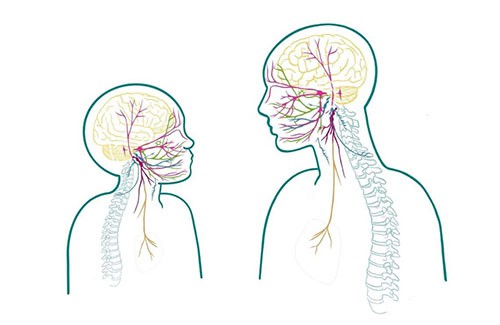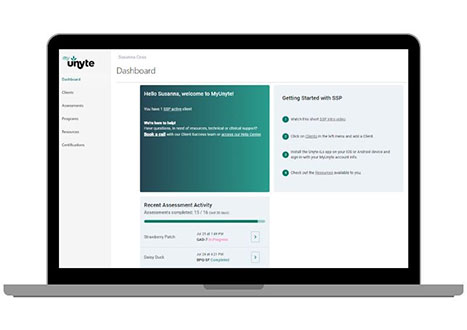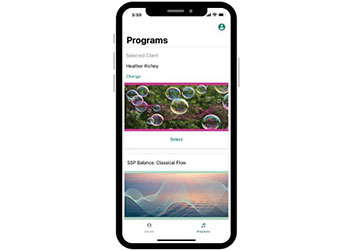
Humans need social connection. We look for cues of safety in other people by reading their faces, body language and tone of voice.
Some people, including adults and children who have experienced really difficult life events, are living with illness or injury, have sensory, learning or developmental differences, such as autism, or for many other reasons, may miss or misinterpret these cues as threatening.
Their autonomic nervous system may be biased toward experiencing the environment as unsafe, which can limit the body’s ability to heal and recover.
Auditory processing is a window into the nervous system. By listening to the specially filtered music of the Safe and Sound Protocol (SSP) in the context of a therapeutic relationship, the nervous system can be repatterned to better perceive calming frequencies, enhancing autonomic regulation by changing the way it responds to cues from the environment.
The SSP helps to regulate the autonomic nervous system and improve auditory processing, leading to better social connection.
When we experience the world as safe, we can more effectively and efficiently use our internal resources to support health and well-being, building the foundation for awareness, embodiment and resilience.
Humans need social connection. We look for cues of safety in other people by reading their faces, body language and tone of voice.
Some people, including adults and children who have experienced really difficult life events, are living with illness or injury, have sensory, learning or developmental differences, such as autism, or for many other reasons, may miss or misinterpret these cues as threatening.
Their autonomic nervous system may be biased toward experiencing the environment as unsafe, which can limit the body’s ability to heal and recover.
Auditory processing is a window into the nervous system. By listening to the specially filtered music of the Safe and Sound Protocol (SSP) in the context of a therapeutic relationship, the nervous system can be repatterned to better perceive calming frequencies, enhancing autonomic regulation by changing the way it responds to cues from the environment.
The SSP helps to regulate the autonomic nervous system and improve auditory processing, leading to better social connection.
When we experience the world as safe, we can more effectively and efficiently use our internal resources to support health and well-being, building the foundation for awareness, embodiment and resilience.
What this means for you and your clients:
Providers report that the SSP “opens up” their clients and relaxes their defenses, improving accessibility.
As a result, clients often experience quicker progress, becoming more engaged in therapy.
The SSP helps accelerate results and improve therapeutic outcomes.
Once integrated, the SSP often becomes an essential part of a clinical approach.
Impactful, long-lasting results for your clients are possible.
The Science of Safety
Explore the science behind the Safe and Sound Protocol
The autonomic nervous system controls the body’s most essential physiological processes, including heart rate, breathing, digestion, and bowel and bladder function. These systems are primarily working automatically, beyond conscious awareness or control. Autonomic state is guided primarily by the vagus nerve (CN X), which serves a key role in communicating information between the brain, body and environment.
Neuroception (different from perception) is a subconscious process of the nervous system in which it evaluates cues from the environment as safe, dangerous or life-threatening. The balance of these cues triggers a corresponding autonomic response, which influences how we feel, think and connect with others.
Auditory processing is the receipt, integration and interpretation of acoustic energy, and is closely linked to other sensory, central and autonomic nervous systems.
Accurate and discriminatory perception of sound is dependent on the function of the middle ear muscles, which tighten the tympanic membrane (eardrum) to support the perception and attenuation of certain frequencies. The middle ear transfer function is connected to a network of cranial nerves that contribute to the integration of sound with other sensory inputs in the brainstem, leading to cognitive, behavioral and physiological responses. The auditory processing system is a portal that fundamentally changes the way we experience and respond to the world.
The social engagement system is an integrated system of cranial nerves and structures of the face and head that enable social behaviors like facial expressions, head-turning, speaking and listening, alongside coordinating essential functions like swallowing, chewing, nursing (infants) and regulation of the heart and lungs. This system has a bidirectional relationship with the cortex and brainstem, where sensory information converges and is processed from the internal and external environment. Through the lens of Polyvagal Theory, the social engagement system evolved to enhance the ability to communicate, collaborate, and build trusting relationships with others from a neurological foundation of safety.

By sending cues of safety through specially filtered music, the SSP engages a system of muscles and nerves that support social engagement, stimulating the vagus nerve. This opens the door for other therapies to become more accessible, impactful and accelerated.
Tunes that retune.
The SSP uses a wide variety of music, including some that you may already be familiar with. All the music in the SSP playlists are thoughtfully sequenced and filtered through the patented, evidence-based algorithm backed by decades of scientific research.
This visual shows full-spectrum sound frequencies in a typical unfiltered clip of popular music.
Here is the exact same clip — after being filtered through the SSP’s algorithm.
What does the music sound like?
The SSP contains several vocal and non-vocal music playlists and levels of filtration to help you support client engagement and participation in the listening process. Multiple vocal and non-vocal playlists allow the SSP to be accessible to many populations, and allow you to customize delivery for your client.
This visual shows the frequencies of vocal music, filtered through the SSP’s algorithm.
This visual shows the frequencies of equally impactful non-vocal music, filtered through the SSP’s algorithm.
Everyone can benefit from
nervous system regulation.
The SSP is suitable across the lifespan, and has been designed to complement a variety of therapeutic approaches and modalities.
SSP providers are psychologists, therapists, social workers, occupational therapists, speech therapists, school counselors, and more.
The SSP may be helpful in reducing symptoms and supporting overall health and resiliency for people seeking support for:
It can be combined with and is supportive of other therapies, including:
Kelly Beins, OTR/L
“The SSP is amazing and has facilitated noticeable change in my clients.”
Laurie Belanger, LCSW-R, EMDRIA Approved Consultant
“Part of the art and science of EMDR therapy is in pacing the experience to avoid overwhelm. The SSP gives us an effective, empowering client tool and an informative therapist gauge to help increase both the safety and quality of the work.”
Ed Bostick, Psychotherapist, hypnotherapist, coach
“The SSP was a necessary and integral part of the client’s overall treatment plan. Client’s self-reported ability to tolerate real and imagined injustices, social situations and work situations, and family encounters increased.”
Jillian Hosey, MSW RSW, LICSW (RI)
“The SSP offers a space to relearn and reconnect to the experience of inner ease, both within the self and within relationship to other, allowing for deeper healing and growth to occur.”
Experience the benefits of the SSP in your practice.
The SSP is trusted by these practitioners and professional organizations as part of their healing toolkit.



Together, clinical trials and real-world evidence create a powerful and holistic evidence base for Unyte programs.
Discover the science behind the transformative power of the Safe and Sound Protocol. Explore real-world case studies demonstrating the wide-ranging impacts of nervous system regulation. View all Case Studies →


The SSP’s effectiveness has been proven in a wide range of clinical studies, including clinical trials involving children and adults with autism. View all Research →


Nervous system regulation through listening: The science and applications
In this white paper, we dive into the profound impact of music-based interventions, sound therapies and listening therapies.
In an exploration of science, clinical research and real-world evidence, we aim to enrich your familiarity with bottom-up therapies and how they can complement traditional, top-down approaches to create holistic healing strategies grounded in physiological safety and autonomic regulation.

Fill out the form to view the white paper:
Deliver from almost anywhere to anyone with the Unyte app.
The SSP is delivered through a user-friendly app-based platform, compatible with Android and iOS devices.
Delivered either in-person or remotely, clients experience the SSP through over-the-ear headphones via the Unyte app. Providers have full control, and can manage client access, deliver listening sessions and monitor progress through MyUnyte, the intuitive platform.
“Safe, sound, and simple. The level of ease and simplicity that comes with SSP digital delivery contributes to keeping the experience within reach of the nervous system’s capacity to safely engage.”

MyUnyte
An intuitive online client management dashboard. Create new accounts, choose SSP programs and pathways, and more in just a few clicks.

Unyte App
Facilitate all your clients’ listening through the Unyte app, available to both providers as well as clients for remote delivery.

Unyte Community
We’re here to support you! Webinars, technical and clinical support, resource articles, online communities, and more are available to all SSP providers as part of your subscription.
Get started today!
You must be a qualified professional to deliver the SSP. SSP Training and Certification covers both theory and the practical application of the Safe and Sound Protocol. Once certified, a subscription is required to deliver the SSP to your clients.
12-month subscription, billed monthly, auto-renewal.
+ $349 $249 one-time purchase of SSP Training and Certification
Pay annually and save!
$1,499 today, billed annually, auto-renewal.
+ $349 $249 one-time purchase of SSP Training and Certification
Have questions? We’re here to guide you!
Book a free, personalized consultation or call us directly at 1-866-594-9453.
| What’s Included | Start with Training Only | Training and Subscription Bundle |
|---|---|---|
| Online, on-demand learning | ✓ | ✓ |
| Special pricing on SSP Training and Certififcation | ✓ | |
| Access to deliver the SSP after becoming certified | Subscription required before you can deliver the SSP | ✓ |
| Access to MyUnyte | ✓ | ✓ |
| Unyte Assessments and Unyte Resources | Limited | ✓ |
| Unyte app for in-person and remote delivery | ✓ | |
| Live and online support, including introductory provider meeting | ✓ |
| What’s Included | Start with Training Only | Training and Subscription Bundle |
|---|---|---|
| Online, on-demand learning | ✓ | ✓ |
| Special pricing on SSP Training and Certififcation | ✓ | |
| Access to deliver the SSP after becoming certified | Subscription required before you can deliver the SSP | ✓ |
| Access to MyUnyte | ✓ | ✓ |
| Unyte Assessments and Unyte Resources | Limited | ✓ |
| Unyte app for in-person and remote delivery | ✓ | |
| Live and online support, including introductory provider meeting | ✓ |
We’re Here To Help!
Discover how the Safe and Sound Protocol can create lasting change for your clients.


We’ll send you the free e-book “Why Effective Processing and Regulation are the Essential Foundation for Health.”

© 2024 Unyte Health US Inc.
Statements on Unyte’ site have not been evaluated by the FDA, and the products and services are not intended to diagnose, treat, cure, or prevent any disease. Unyte products are not medical devices or medical instruments.
It is solely the responsibility of each user (whether a professional user or personal user) to determine whether the products and/or services may be beneficial for their patients/clients or themselves.
Contact UsWe're not around right now. But you can send us an email and we'll get back to you, asap.
Start typing and press Enter to search
We use cookies on our site to improve and personalize your experience by remembering your preferences and repeat visits, analyzing how our site is used, and to keep it reliable and secure. By using our website, you agree to our Privacy Policy and our cookies usage.
Manage consentThis website uses cookies to improve your experience while you navigate through the website. Out of these, the cookies that are categorized as necessary are stored on your browser as they are essential for the working of basic functionalities of the website. We also use third-party cookies that help us analyze and understand how you use this website. These cookies will be stored in your browser only with your consent. You also have the option to opt-out of these cookies. But opting out of some of these cookies may affect your browsing experience.
Always EnabledNecessary cookies are absolutely essential for the website to function properly. These cookies ensure basic functionalities and security features of the website, anonymously.
| Cookie | Duration | Description |
|---|---|---|
| cookielawinfo-checkbox-advertisement | 1 year | Set by the GDPR Cookie Consent plugin, this cookie records the user consent for the cookies in the "Advertisement" category. |
| cookielawinfo-checkbox-analytics | 11 months | This cookie is set by GDPR Cookie Consent plugin. The cookie is used to store the user consent for the cookies in the category "Analytics". |
| cookielawinfo-checkbox-functional | 11 months | The cookie is set by GDPR cookie consent to record the user consent for the cookies in the category "Functional". |
| cookielawinfo-checkbox-necessary | 11 months | This cookie is set by GDPR Cookie Consent plugin. The cookies is used to store the user consent for the cookies in the category "Necessary". |
| cookielawinfo-checkbox-others | 11 months | This cookie is set by GDPR Cookie Consent plugin. The cookie is used to store the user consent for the cookies in the category "Other. |
| cookielawinfo-checkbox-performance | 11 months | This cookie is set by GDPR Cookie Consent plugin. The cookie is used to store the user consent for the cookies in the category "Performance". |
| CookieLawInfoConsent | 1 year | CookieYes sets this cookie to record the default button state of the corresponding category and the status of CCPA. It works only in coordination with the primary cookie. |
| viewed_cookie_policy | 11 months | The cookie is set by the GDPR Cookie Consent plugin and is used to store whether or not user has consented to the use of cookies. It does not store any personal data. |
| _GRECAPTCHA | 5 months 27 days | This cookie is set by the Google recaptcha service to identify bots to protect the website against malicious spam attacks. |
| __hssc | 30 minutes | HubSpot sets this cookie to keep track of sessions and to determine if HubSpot should increment the session number and timestamps in the __hstc cookie. |
| __hssrc | session | This cookie is set by Hubspot whenever it changes the session cookie. The __hssrc cookie set to 1 indicates that the user has restarted the browser, and if the cookie does not exist, it is assumed to be a new session. |
Functional cookies help to perform certain functionalities like sharing the content of the website on social media platforms, collect feedbacks, and other third-party features.
| Cookie | Duration | Description |
|---|---|---|
| lidc | 1 day | LinkedIn sets the lidc cookie to facilitate data center selection. |
| li_gc | 5 months 27 days | Linkedin set this cookie for storing visitor's consent regarding using cookies for non-essential purposes. |
| UserMatchHistory | 1 month | LinkedIn sets this cookie for LinkedIn Ads ID syncing. |
| __cf_bm | 30 minutes | Cloudflare set the cookie to support Cloudflare Bot Management. |
Performance cookies are used to understand and analyze the key performance indexes of the website which helps in delivering a better user experience for the visitors.
| Cookie | Duration | Description |
|---|---|---|
| SRM_B | 1 year 24 days | Used by Microsoft Advertising as a unique ID for visitors. |
| _uetsid | 1 day | Bing Ads sets this cookie to engage with a user that has previously visited the website. |
| _uetvid | 1 year 24 days | Bing Ads sets this cookie to engage with a user that has previously visited the website. |
Analytical cookies are used to understand how visitors interact with the website. These cookies help provide information on metrics the number of visitors, bounce rate, traffic source, etc.
| Cookie | Duration | Description |
|---|---|---|
| AnalyticsSyncHistory | 1 month | Linkedin set this cookie to store information about the time a sync took place with the lms_analytics cookie. |
| CLID | 1 year | Microsoft Clarity set this cookie to store information about how visitors interact with the website. The cookie helps to provide an analysis report. The data collection includes the number of visitors, where they visit the website, and the pages visited. |
| CONSENT | 2 years | YouTube sets this cookie via embedded youtube-videos and registers anonymous statistical data. |
| hubspotutk | 5 months 27 days | HubSpot sets this cookie to keep track of the visitors to the website. This cookie is passed to HubSpot on form submission and used when deduplicating contacts. |
| MR | 7 days | This cookie, set by Bing, is used to collect user information for analytics purposes. |
| SM | session | Microsoft Clarity cookie set this cookie for synchronizing the MUID across Microsoft domains. |
| _clck | 1 year | Microsoft Clarity sets this cookie to retain the browser's Clarity User ID and settings exclusive to that website. This guarantees that actions taken during subsequent visits to the same website will be linked to the same user ID. |
| _clsk | 1 day | Microsoft Clarity sets this cookie to store and consolidate a user's pageviews into a single session recording. |
| _fbp | 3 months | Facebook sets this cookie to display advertisements when either on Facebook or on a digital platform powered by Facebook advertising after visiting the website. |
| _ga | 2 years | The _ga cookie, installed by Google Analytics, calculates visitor, session and campaign data and also keeps track of site usage for the site's analytics report. The cookie stores information anonymously and assigns a randomly generated number to recognize unique visitors. |
| _ga_* | 1 year 1 month 4 days | Google Analytics sets this cookie to store and count page views. |
| _gcl_au | 3 months | Google Tag Manager sets the cookie to experiment advertisement efficiency of websites using their services. |
| _gid | 1 day | Installed by Google Analytics, _gid cookie stores information on how visitors use a website, while also creating an analytics report of the website's performance. Some of the data that are collected include the number of visitors, their source, and the pages they visit anonymously. |
| _hjAbsoluteSessionInProgress | 30 minutes | Hotjar sets this cookie to detect the first pageview session of a user. This is a True/False flag set by the cookie. |
| _hjFirstSeen | 30 minutes | Hotjar sets this cookie to identify a new user’s first session. It stores a true/false value, indicating whether it was the first time Hotjar saw this user. |
| _hjIncludedInPageviewSample | 2 minutes | Hotjar sets this cookie to know whether a user is included in the data sampling defined by the site's pageview limit. |
| _hjIncludedInSessionSample | 2 minutes | Hotjar sets this cookie to know whether a user is included in the data sampling defined by the site's daily session limit. |
| _hjSessionUser_* | 1 year | Hotjar sets this cookie to ensure data from subsequent visits to the same site is attributed to the same user ID, which persists in the Hotjar User ID, which is unique to that site. |
| _hjSession_* | 30 minutes | Hotjar sets this cookie to ensure data from subsequent visits to the same site is attributed to the same user ID, which persists in the Hotjar User ID, which is unique to that site. |
| __hstc | 5 months 27 days | Hubspot set this main cookie for tracking visitors. It contains the domain, initial timestamp (first visit), last timestamp (last visit), current timestamp (this visit), and session number (increments for each subsequent session). |
Advertisement cookies are used to provide visitors with relevant ads and marketing campaigns. These cookies track visitors across websites and collect information to provide customized ads.
| Cookie | Duration | Description |
|---|---|---|
| ANONCHK | 10 minutes | The ANONCHK cookie, set by Bing, is used to store a user's session ID and verify ads' clicks on the Bing search engine. The cookie helps in reporting and personalization as well. |
| bcookie | 1 year | LinkedIn sets this cookie from LinkedIn share buttons and ad tags to recognize browser IDs. |
| bscookie | 1 year | LinkedIn sets this cookie to store performed actions on the website. |
| li_sugr | 3 months | LinkedIn sets this cookie to collect user behaviour data to optimise the website and make advertisements on the website more relevant. |
| MUID | 1 year 24 days | Bing sets this cookie to recognise unique web browsers visiting Microsoft sites. This cookie is used for advertising, site analytics, and other operations. |
| test_cookie | 15 minutes | doubleclick.net sets this cookie to determine if the user's browser supports cookies. |
| VISITOR_INFO1_LIVE | 5 months 27 days | A cookie set by YouTube to measure bandwidth that determines whether the user gets the new or old player interface. |
| YSC | session | YSC cookie is set by Youtube and is used to track the views of embedded videos on Youtube pages. |
| yt-remote-connected-devices | never | YouTube sets this cookie to store the video preferences of the user using embedded YouTube video. |
| yt-remote-device-id | never | YouTube sets this cookie to store the video preferences of the user using embedded YouTube video. |
| yt.innertube::nextId | never | This cookie, set by YouTube, registers a unique ID to store data on what videos from YouTube the user has seen. |
| yt.innertube::requests | never | This cookie, set by YouTube, registers a unique ID to store data on what videos from YouTube the user has seen. |
Other uncategorized cookies are those that are being analyzed and have not been classified into a category as yet.
| Cookie | Duration | Description |
|---|---|---|
| gclid | 1 month | No description |
| pum-47676 | 1 month | Description is currently not available. |
| VISITOR_PRIVACY_METADATA | 5 months 27 days | Description is currently not available. |
| _hjIncludedInSessionSample_2586197 | 2 minutes | Description is currently not available. |
| _hjSessionUser_2586197 | 1 year | No description |
| _hjSession_2586197 | 30 minutes | No description |
| _OG_GDPR_COOKIE_ | session | No description available. |